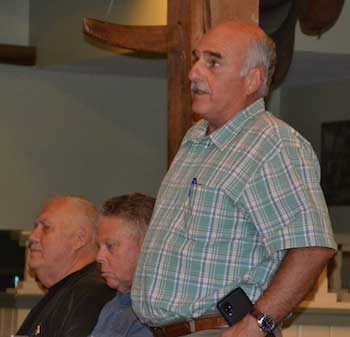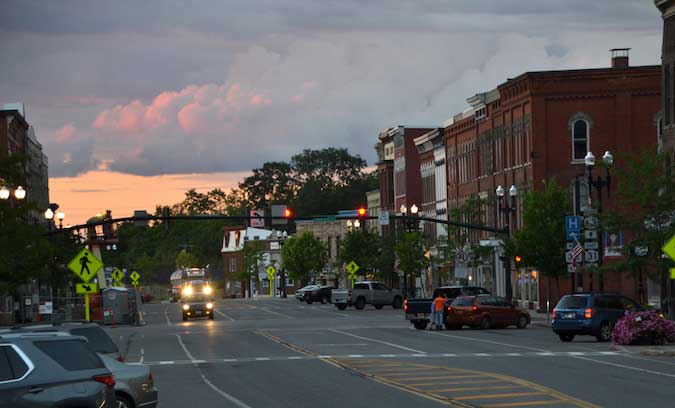County will give towns, villages full shares of local sales tax
ALBION – Town and village officials in Orleans County have been bracing for a cut in local sales tax payments, were are distributed by the County Legislature.
The county in late June announced the payments would be delayed and perhaps reduced do to a slowing economy. The county’s sales tax revenue was down about $1 million in April and May compared to those months in 2019.

Orleans County Legislator John DeFilipps tells town and village officials they won’t be taking a local sales tax hit this year. DeFilipps is speaking Tuesday evening at the monthly Orleans County Association of Municipalities, which was held at Tillman’s Village Inn. County Legislator Ken DeRoller, center, and Gaines Town Justice Bruce Schmidt, left, are among the local officials who attended the meeting.
But the sales tax has since rebounded, now just slightly ahead of the pace from 2019. The revenue is up $62,040 or 0.1%. With sales tax now holding steady, county officials agreed to keep the towns and villages whole for 2020.
“With sales tax coming back, we will be releasing the money,” County Legislator John DeFilipps, chairman of the county’s finance committee, told town and village officials on Tuesday during the Orleans County Association of Municipalities.
The county will soon be sending out $961,618 among the 10 towns and four villages. The Legislature in April approved the first payment of $405,053.
With the sales tax sharing agreement, the county distributes $1,366,671 to towns and villages. That has been the number since 2001.
This is how the money is to be divvied up this year:
Villages – $375,620 total in 2020
Albion, $165,688; Holley, $45,051; Lyndonville, $15,243; and Medina, $149,638.
Towns – $991,051 total in 2020
Albion, $123,143; Barre, $64,536; Carlton, $95,418; Clarendon, $116,261; Gaines, $88,698; Kendall, $86,813; Murray, $113,915; Ridgeway, $130,143; Shelby, $105,811; and Yates, $66,312.
The funding is typically paid quarterly. The county made the first payment on April 1, but hasn’t made any since.
DeFilipps said he remains concerned about the sales tax revenue because they economy hasn’t fully reopened.
“We don’t know what will happen in the future,” he said. “In the future, we may decide to hold back some of the sales tax.”
Jack Welch, the county’s chief administrative officer, said the state is diverting some of the local sales tax.
The county will see $102,814 in its sales tax withheld by the state in January and diverted to the Fiscally Distressed Hospital Fund, with another $87,460 to be withheld later 2021, Welch said.
The county also will have $290,276 taken from its sales tax for AIM (Aid and Incentives to Municipalities). That used to be paid for by the state to some towns and villages but now comes from the local sales tax.
The shifting of sales tax to Aim and the Distressed Hospital Fund will cost the county $480,550, Welch said.
The sales tax was lagging behind last year’s pace, but Welch said growth in sales tax on internet sales helped the county hold steady in sales tax revenue.
The county saw the biggest decline in sales from March through May in the following categories:
• Automobile sales, down 38 percent compared to same period in 2019
• Restaurants and other eating places, down 26 percent
• Gasoline sales down 21.1 percent, and petroleum and petroleum products wholesale down 34.9 percent. The cost of fuel dropped about 18 percent and consumption is expected to decline about 10 percent for the year, Welch said.
Lynne Johnson, the County Legislature chairwoman, said she recognizes the towns and villages have their own fiscal challenges and need the full amount of sales tax they were expecting in their budgets.
“We’re a partnership here with the county and the towns,” she said. “One situation that has come out of Covid, it has brought us closer – the county and the towns.”








































































